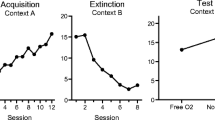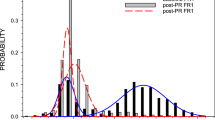Abstract
The development of a secondary reinforcer as a result of associating a neutral stimulus (buzzer) with intravenous (IV) doses of morphine was studied in rats. Secondary reinforcement developed in the absence of physical dependence and followed the association of the stimulus with either response-contingent or non-contingent injections of morphine. Strength of the conditioned reinforcer, measured in terms of responding on a lever for the stimulus plus infusion of saline solution, was proportional to the unit dosage of morphine employed in pairings of buzzer and drug. When extinction of the lever-press response for IV morphine was conducted (by substituting saline for morphine solution) in the absence of the conditioned reinforcing stimulus, it was seen later that the stimulus could still elicit lever responses, until it too had been present for a sufficient interval of non-reinforced responding. Similarly, extinction of the response for morphine by blocking its action with naloxone in the absence of the stimulus did not eliminate the conditioned reinforcement. Another study showed that a passive, subcutaneous (SC) dose of morphine served to maintain lever-pressing on a contingency of buzzer plus sahne infusion. Furthermore, the stimuli resulting from the presence of morphine (after a SC injection) were able to reinstate the lever-responding with only the buzzer-saline contingency when such responses had previously been extinguished. Moreover, it was shown thatd-amphetamine could restore responding under the same conditions, and that morphine could also do so for rats in which the primary reinforcer had beend-amphetamine. It is suggested that animal data such as these show that procedures designed for the elimination of human drug-taking behavior must take into account secondary reinforcers as well as the primary reinforcer(s).
Similar content being viewed by others
References
Babbini, M. and Davis, W. M.: Time-dose relationships for locomotor activity effects of morphine after acute or repeated treatment.Br. J. Pharmacol. 46:213–224, 1972.
Crowder, W. F., Smith, S. G., Davis, W. M., Noel, J. J., and Coussens, W. R.: Effect of morphine dose size on the conditioned reinforcing potency of stimuli paired with morphine.Psychol. Rec. 22:441–448, 1972.
Davis, W. M., Babbini, M., and Khalsa, J. H.: Antagonism by alpha-methyltyrosine of morphine induced motility in non-tolerant and tolerant rats.Res. Commun. Chem. Pathol. Pharmacol. 4:267–279, 1972.
Davis, W. M., Holbrook, J. M., and Babbini, M.: Differential effect of morphine on active avoidance as a function of pre-drug performance.Pharmacol. Res. Commun. 5:47–53, 1973.
Davis, W. M. and Smith, S. G.: Blocking of morphine based reinforcement by alpha-methyltyrosine.Life Sci. 12:185–191, 1973a.
Davis, W. M. and Smith, S. G.: Blocking effect of alpha-methyltyrosine on amphetamine based reinforcement.J. Pharm. Pharmacol. 25:174–177, 1973b.
Davis, W. M. and Smith, S. G.: Naloxone use to eliminate opiate-seeking behavior: Need for extinction of conditioned reinforcement.Biol. Psychiat. 9:181–189, 1974a.
Davis, W. M. and Smith, S. G.: Behavioral control exerted by an amphetamine based conditioned reinforcer.In J. Singh and H. Lal (Eds.): Drug Addiction, Vol. 3: Neurobiology and Influences on Behavior. New York, Stratton Intercontinental Medical Book Corp., 1974b; pp. 209–219.
Davis, W. M. and Smith, T. P.: Morphine enhancement of shuttle avoidance prevented by a-methyltyrosine.Psychopharmacologia 44:95–97, 1975.
Keller, F. S. and Schoenfeld, W. N.: Principles of Psychology. New York, Appleton-Century-Crofts, 1950.
Kumar, R.: Morphine dependence in rats: Secondary reinforcement from environmental stimuli.Psychopharmacologia 25:332–338, 1972.
Lynch, J. J., Fertziger, A. P., Teitelbaum, H. A., Cullen, J. W., and Gantt, H. W.: Pavlovian conditioning of drug reactions: Some implications for problems of drug addiction.Cond. Reflex. 8:4–211, 1973.
Pavlov, I. P.: Conditioned Reflexes. Translated by G. Anrep. New York, Oxford University Press, 1927.
Schuster, C. R. and Thompson, T.: Self-administration of and behavioral dependence on drugs.Ann. Rev. Pharmacol. 9:483–502, 1969.
Schuster, C. R. and Woods, J. H.: The conditioned reinforcing effects of stimuli associated with morphine reinforcement.Int. J. Addict. 3:223–230, 1968.
Smith, S. G. and Davis, W. M.: Behavioral control by stimuli associated with acquisition of morphine self-administration.Behav. Biol. 9:777–780, 1973.
Smith, S. G. and Davis, W. M.: A method for chronic intravenous drug administration in the rat.In S. Ehrenpreis and A. Neidle (Eds.): Methods in Narcotics Research. New York, Marcel Dekker, 1975; pp. 3–32.
Stolerman, I. P. and Kumar, R.: Secondary reinforcement in opioid dependence.In J. M. Singh, L. H. Miller, and H. Lal (Eds.): Drug Addiction, Vol. 1: Experimental Pharmacology. New York, Futura, 1972; pp. 49–59.
Wilder, A.: Some implications of conditioning theory for problems of drug abuse.Behav. Sct. 16:92–97, 1971.
Wilder, A.: Dynamics of drug dependence. Implications of a conditioning theory for research and treatment.Arch. Gen. Psychiat. 28:611–617, 1973.
Wilder, A., Pescor, F. T., Miller, D., and Norrell, H.: Persistent potency of a secondary (conditioned) reinforcer following withdrawal of morphine from physically dependent rats.Psychopharmacologia 20:103–117, 1971.
Author information
Authors and Affiliations
Additional information
This work was supported by PHS research grants MH 11295-06, MH 13570-03 and DA 00018-07, 08 and in part by the Research Institute of Pharmaceutical Sciences of the University of Mississippi School of Pharmacy.
Rights and permissions
About this article
Cite this article
Davis, W.M., Smith, S.G. Role of conditioned reinforcers in the initiation, maintenance and extinction of drug-seeking behavior. Pav. J. Biol. Sci. 11, 222–236 (1976). https://doi.org/10.1007/BF03000316
Issue Date:
DOI: https://doi.org/10.1007/BF03000316




